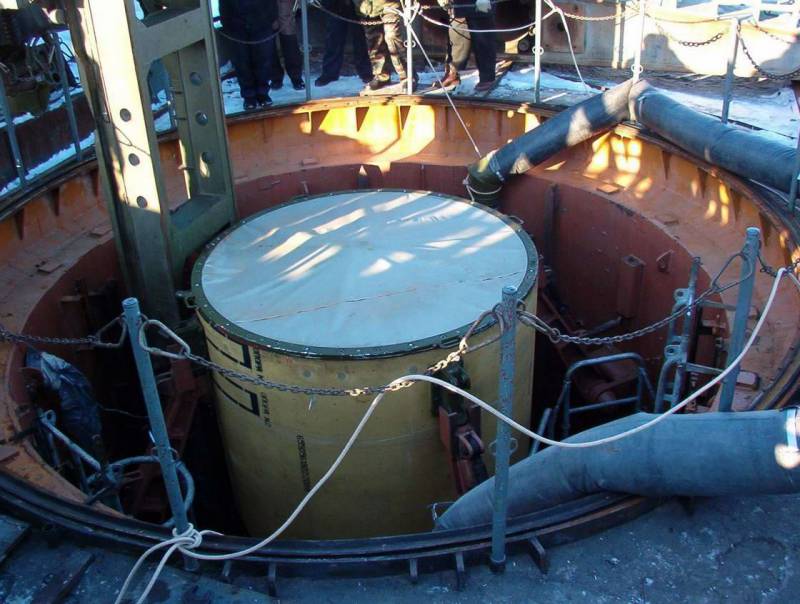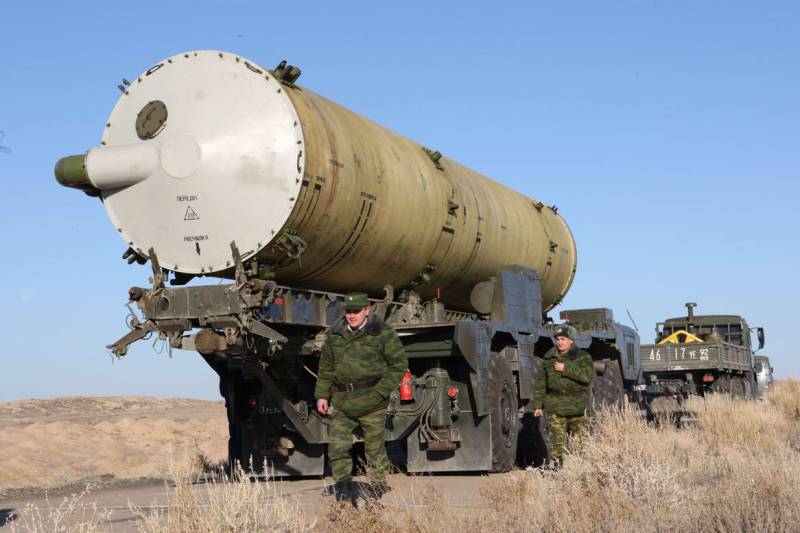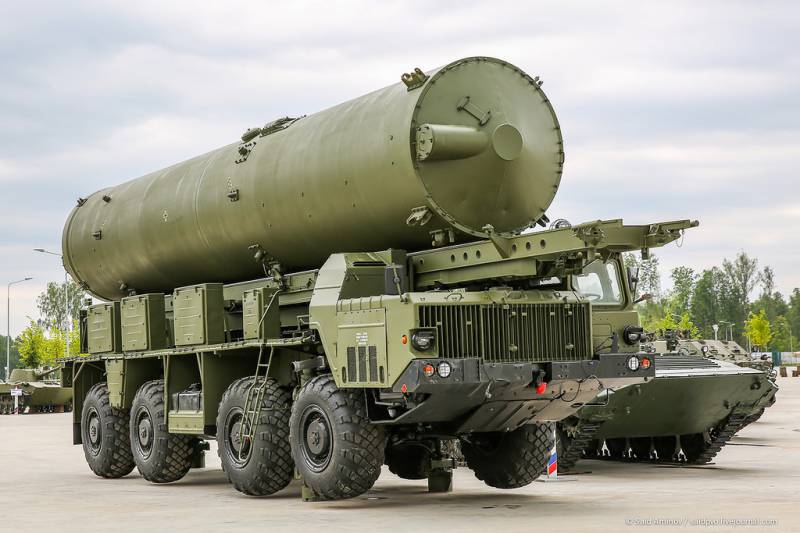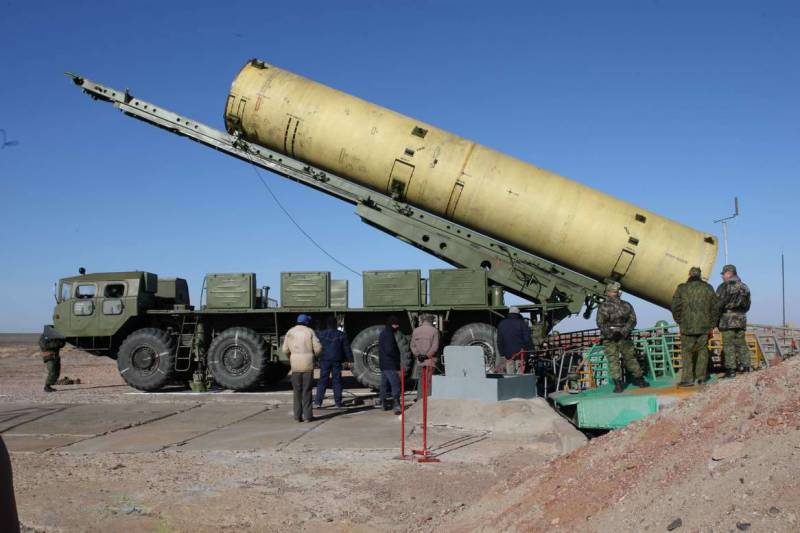5Т92 transport-charging machine complex A-135 PRO
A car appeared at the exhibition site on the basis of a special multi-axle chassis with systems for transporting and loading missile weapons used by an anti-missile defense system. So, on the corresponding fastenings of the lifting device of the museum machine 5Т92 is the layout of the transport and launch container of the guided missile 53Т6. The rocket itself cannot yet be shown to anyone. Previously published photographs and videos of launches of these products, but the normal images of missiles still remain under the heading of secrecy.
The 5Т92 transport-loading vehicle (TZM) was developed as part of the creation of the A-135 missile defense system. The composition of this complex was to include a wide range of various products for various purposes. The main elements of the system were supposed to be radar stations, command posts and firing systems. In addition, various auxiliary systems, transport machines, etc., should have been operated in the A-135. One of these additional funds and was supposed to be TZM 5T92. Another version of the transport vehicle was also developed. This technique was to be used for the transportation and loading of various types of interceptor missiles into launchers.
The TZM 5Т92 was created to work with transport-launch containers of the 53Т6 antimissile. The task of this technique is to receive a container with an interceptor missile from a transport vehicle and further place it in a silo-type launcher. All such operations are carried out by the 5Т92 machine independently, using standard tools. After the download is complete, the TPK launcher with the missile is ready for use for its intended purpose.
The basis for the transport-charging vehicle of the anti-missile complex was the all-wheel drive four-axle chassis MAZ-543 / MAZ-7310 (the exhibition sample 5Т92 is based on the MAZ-543М with a different layout of the front part and one cabin instead of two), also used as a basis for special equipment of various destination. The chassis is equipped with an engine power 525 hp, which allows it to carry a load weighing up to 20 t and move at speeds up to 55 km / h. With the help of a wheeled undercarriage with an independent torsion bar suspension, high cross-country ability is provided with the ability to move both on the highway and on rough terrain.
Due to the need to use as a basis for a special technique, the MAZ-7310 family chassis received the appropriate layout. So, in front of the machine is placed the body with the engine compartment and the cockpit. Depending on the modification, two cabs can be used, located on either side of the engine, or only one, placed on the left. Behind the frame is placed a frame with various units, including the transmission and the wheeled chassis. A characteristic feature of the chassis is the use of hydromechanical transmission, which made it possible to optimize the design of the transmission. The axles of the chassis are located with different distances from each other. In the increased interval between the second and third axles fuel tanks are located.
A special platform with a set of necessary equipment is mounted on the TZM base chassis. At the sides of this platform is a set of boxes to accommodate a number of components and assemblies. In addition, between the first and second, as well as behind the fourth axis, hydraulic outrigger jacks are attached, designed to hold the machine in the correct position during the operations of reloading containers with missiles.
The central part of the platform is intended for the installation of a lifting device necessary for the transportation and installation of a WPC in a launcher. This device is made in the form of a lifting boom with hydraulic actuators, equipped with a frame with systems for working with missile defense systems. In the transport position, the frame of the lifting device is laid along the body, beyond the size of the machine. In this case, the front / upper part of the frame is located between the cabs (in the case of a two-cabin chassis) or to the right of the only compartment for the crew.
On the frame of the lifting device are fasteners to hold the rocket container in the desired position. Fasteners for the container are placed on movable bases and can move along the frame when loading the container into the mine or removing the empty product from the launcher. The attachment and the container are moved using a system of cables and a winch.
The transport and launch container of the anti-missile 53Т6 is a cylindrical product with end caps in the shape of a truncated cone. On the outer surface of the container there is a set of fasteners for transportation on the TZM and in the launcher. A set of various connectors is also provided for connecting the rocket systems with the control equipment installed in the launch shaft.
Operation TZM 5Т92 is as follows. The car comes under its own power to the specified launch pad where the launcher will be reloaded. At the same time, special equipment of the machine is not normally used to transport a container with a rocket. The product 53Т6 is proposed to be transported using a separate transport type 5Т93.
The 5Т93 transport vehicle, designed for use with the 5Т92, is built on a similar chassis, has a similar equipment, but differs markedly from the transport and charging. Thus, the upper frame of the transport vehicle does not have lifting mechanisms and can only be in one position. The frame provides mounting for the container and mechanisms for moving it. Also used a leveling system in the form of four hydraulic supports. For operation at any time of year, the 5Т93 machine is equipped with a temperature control system necessary to maintain the required conditions inside the transport and launch container. With the help of this equipment, the rocket remains in the optimal microclimate until the moment of overload on the TZM.
After the arrival of both special machines on the launch pad, the missile defense complex is overloaded. TZM occupies the desired position near the launch shaft, allowing you to load a rocket. Then before it becomes a transport machine 5Т93. In order to avoid equipment shifts and to maintain the required position of the two machines, outrigger jacks are used. The container is overloaded with the help of its own cable devices of the transport vehicle. Upon completion of the overload, the transport and charging vehicle may proceed to loading the container into the launch shaft.
Using hydraulic actuators, the boom is raised with the rocket container in a vertical position. After that, the bottom end of the TPK should be strictly above the internal channel of the launcher. Then, the mechanisms of the transport-charging vehicle, according to the appropriate command, begin to feed the WPC down, placing it in the starting shaft. After the download is complete, the calculation should connect the various connectors and connect the rocket to the systems responsible for managing its operation, maintaining the required conditions, etc. The crew of the TZM 5Т92, in turn, must transfer the lifting device to the transport position, raise the supports and may decrease from the position.
[Center]

The container with the missile in the mine, the frame TZM has not yet been removed. Photo Rbase.new-factoria.ru
Unloading of the empty transport and launch container from the mine is carried out in a similar way, but in the reverse order. Upon arrival and hanging out on supports, the 5Т92 raises the frame to a vertical position, seizes the used container and lifts it, removing it from the launcher, after which it becomes possible to place a new missile into the shaft.
As far as is known, the 53Т6 interceptor missile (the project’s earlier name is PRS-1) was created at the Novator Design Bureau with the goal of expanding the combat capabilities of the A-135 missile defense system. This product was proposed to be included in the near atmospheric level of the missile defense system. Also created a long-range rocket 51Т6 with other characteristics. Work on the creation of a new type of rocket and all the necessary auxiliary systems started in the early seventies. By the end of the decade, it was possible to complete the development of all the basic systems of the new A-135 complex, and also to begin preparing for their testing.
The first launch of the 53Т6 rocket took place at the end of the summer of 1979. In these tests, a silo launcher, proposed for deployment in a combat version of the complex, was used. In addition, the 5Т92 transport-loading machine was to be used to load a TPK with a rocket into the launcher. The testing and refinement of the 53Т6 product continued until the spring of the 1984 year. Together with experienced missiles, it was likely that TZMs with the required equipment were also used.
In the first half of the eighties in the Moscow region, construction was carried out on all the main facilities of the future anti-missile defense complex A-135. By the middle of the decade, most of the facilities were completed, after which preparations for the deployment of systems began. In 1989, the serial production of 53Т6 missiles started. These products were delivered to the units engaged in the Moscow PRO, where they were used in conjunction with newly built launchers and auxiliary equipment.
In parallel with the construction of facilities in the Moscow region, tests were conducted at the Sary-Shagan test site. From 1982 to 1990, 22 launched 53Т6 missiles on this site. These test launches were conducted during the three stages of testing and state testing. In addition, missiles of this type received non-nuclear warheads under the Samolet-M program. A similar modification of the anti-missile was also tested at the Sary-Shagan test site. All stages of the tests were carried out using a number of different systems and equipment samples. Among others, the transport-charging machines 5Т92 participated in these works.
[Center]

Transport machine 5Т93 with a rocket container. Photo Rbase.new-factoria.ru
11 February 1991 began the trial operation of the A-135 complex with combat duty. The radar systems began to monitor the situation, and the firing systems received the required number of missiles intended to intercept detected targets. Missiles 53Т6, according to reports, were deployed in five launch areas. Such facilities received 12 or 16 silo launchers and could keep an appropriate number of interceptors on duty. At the disposal of each part responsible for the operation of the launch pads, there were a number of transport and transport-charging machines.
1 December 1995 of the year began the full combat duty of the A-135 complex. The following year, the missile defense system was officially adopted. By this time, all elements of the complex, including auxiliary equipment, had already been mastered by personnel and tested during duty or during training events.
In 2006, it was decided to remove the anti-missiles 51Т6 from duty and armament, with the result that the only weapons A-135 complex left 53Т6 products. In total, at that time it was possible to deploy up to 68 missiles of this type. Soon began to appear fragmentary information about the possible modernization of the missile defense system and the creation of an improved version of the 53Т6 rocket. It is known that according to the results of the state tests of the rocket, the possibility of its further improvement was established. Calculations have shown that by further improving its design, it is possible to increase the interception range by 2,5 times and heights by 3 times.
The anti-missile defense complex A-135 continues to be in service and to ensure the protection of Moscow and the central industrial region. The main armament of the complex at the moment are 53T6 missiles. These products are transported and operated together with a special container, greatly simplifying their operation. In the expanded state in the five firing systems can be up to 68 missiles. During the tests and combat duty in total, about fifty launches were performed.
During all test and training launches, a significant amount of auxiliary equipment of various types of one or another purpose was used. An important role in these events was played by transport vehicles 5Т93 and transport-charging 5Т92. Keeping the 53Т6 missiles in service, as well as their possible modernization (without major changes in size and weight), will allow the operation of the corresponding auxiliary equipment to continue. Thus, in the foreseeable future, not only the missile defense radar stations, control systems and anti-missile systems, but also transport and transport-loading vehicles will remain in service with the Aerospace Forces.
Until recently, the general public could see the TZM 5Т92 and TPC 53Т6 missiles from the PRO-A-135 complex only in photographs. Now everyone has the opportunity to personally see a sample of such equipment, as well as carefully examine it from all sides and carefully study the design. A unique sample of auxiliary equipment, apparently previously used by the military, is now on display at the Patriot Park.
On the materials of the sites:
http://rbase.new-factoria.ru/
http://patriotp.ru/
http://pvo.guns.ru/
http://saidpvo.livejournal.com/
Photo review of the museum transport-loading machine:
http://saidpvo.livejournal.com/517534.html


Information